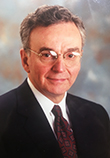|

Biography

 |
Dr. Joseph Bordogna
Deputy Director
Chief Operating Officer
National Science Foundation
1999-2005
Credit: National Science Foundation Collection
|
Dr. Joseph Bordogna was National Science Foundation (NSF) Deputy Director from June 1999 to June 2005. The text reflects his biography at the time he was deputy director.
Dr. Bordogna is Deputy Director and Chief Operating
Officer of NSF and served
previously as acting deputy director and as head of NSF's Directorate for Engineering.
Complementing his NSF duties, he is a member of the
President's Management Council; has chaired Committees
on Manufacturing, Environmental Technologies, and
Automotive Technologies within the President's National
Science and Technology Council; and was a member of
the U.S.-Japan Joint Optoelectronics Project.
He received the B.S.E.E. and Ph.D. degrees from the
University of Pennsylvania and the S.M. degree from
the Massachusetts Institute of Technology. As well
as his assignment at NSF, his career includes experience
as a line officer in the U.S. Navy, a practicing engineer
in industry, and a professor.
Prior to appointment at NSF, he served at the University
of Pennsylvania as Alfred Fitler Moore Professor of
Engineering, Director of The Moore School of Electrical
Engineering, Dean of the School of Engineering and
Applied Science, and Faculty Master of Stouffer College
House, a living-learning student residence at the
University.
He has made contributions to the engineering profession
in a variety of areas including early laser communications
systems, electro-optic recording materials, holographic
television playback systems, and early space capsule
recovery. He was a founder of PRIME (Philadelphia
Regional Introduction for Minorities to Engineering)
and served on the Board of The Philadelphia Partnership
for Education, community coalitions providing, respectively,
supportive academic programs for K-12 students and
teachers.
He is a Fellow of the American Association for the
Advancement of Science (AAAS), the American Society
for Engineering Education (ASEE), the Institute of
Electrical and Electronics Engineers (IEEE), and the
International Engineering Consortium. He also served
his profession globally as president of the IEEE.
|











